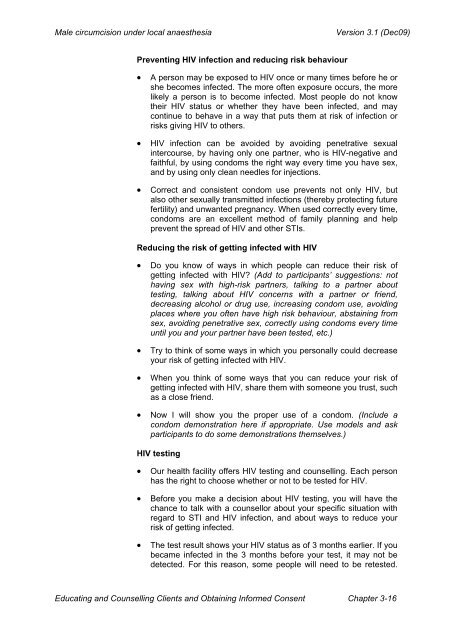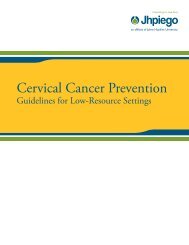Manual for Male Circumcision under Local Anaesthesia
Manual for Male Circumcision under Local Anaesthesia
Manual for Male Circumcision under Local Anaesthesia
Create successful ePaper yourself
Turn your PDF publications into a flip-book with our unique Google optimized e-Paper software.
<strong>Male</strong> circumcision <strong>under</strong> local anaesthesia<br />
Version 3.1 (Dec09)<br />
Preventing HIV infection and reducing risk behaviour<br />
• A person may be exposed to HIV once or many times be<strong>for</strong>e he or<br />
she becomes infected. The more often exposure occurs, the more<br />
likely a person is to become infected. Most people do not know<br />
their HIV status or whether they have been infected, and may<br />
continue to behave in a way that puts them at risk of infection or<br />
risks giving HIV to others.<br />
• HIV infection can be avoided by avoiding penetrative sexual<br />
intercourse, by having only one partner, who is HIV-negative and<br />
faithful, by using condoms the right way every time you have sex,<br />
and by using only clean needles <strong>for</strong> injections.<br />
• Correct and consistent condom use prevents not only HIV, but<br />
also other sexually transmitted infections (thereby protecting future<br />
fertility) and unwanted pregnancy. When used correctly every time,<br />
condoms are an excellent method of family planning and help<br />
prevent the spread of HIV and other STIs.<br />
Reducing the risk of getting infected with HIV<br />
• Do you know of ways in which people can reduce their risk of<br />
getting infected with HIV (Add to participants’ suggestions: not<br />
having sex with high-risk partners, talking to a partner about<br />
testing, talking about HIV concerns with a partner or friend,<br />
decreasing alcohol or drug use, increasing condom use, avoiding<br />
places where you often have high risk behaviour, abstaining from<br />
sex, avoiding penetrative sex, correctly using condoms every time<br />
until you and your partner have been tested, etc.)<br />
• Try to think of some ways in which you personally could decrease<br />
your risk of getting infected with HIV.<br />
• When you think of some ways that you can reduce your risk of<br />
getting infected with HIV, share them with someone you trust, such<br />
as a close friend.<br />
• Now I will show you the proper use of a condom. (Include a<br />
condom demonstration here if appropriate. Use models and ask<br />
participants to do some demonstrations themselves.)<br />
HIV testing<br />
• Our health facility offers HIV testing and counselling. Each person<br />
has the right to choose whether or not to be tested <strong>for</strong> HIV.<br />
• Be<strong>for</strong>e you make a decision about HIV testing, you will have the<br />
chance to talk with a counsellor about your specific situation with<br />
regard to STI and HIV infection, and about ways to reduce your<br />
risk of getting infected.<br />
• The test result shows your HIV status as of 3 months earlier. If you<br />
became infected in the 3 months be<strong>for</strong>e your test, it may not be<br />
detected. For this reason, some people will need to be retested.<br />
Educating and Counselling Clients and Obtaining In<strong>for</strong>med Consent Chapter 3-16
















